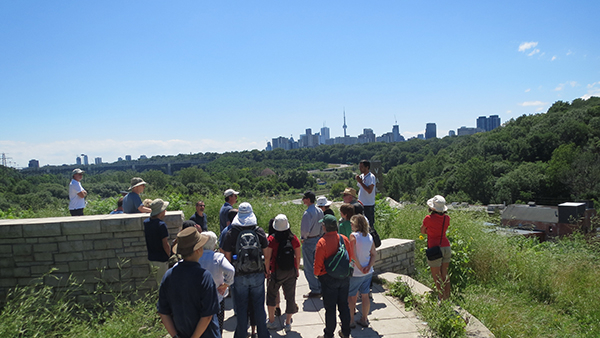Fossil-finding Tour at Evergreen Brick Works

By Kevin Seymour
Photos by I-Cheng Chen and Jasmine Lin

Dr. A.P. Coleman, who later became the director of the Royal Ontario Museum of Geology, first drew attention to this site in 1894. More particularly, he drew attention to the amazing sediments preserved here. Over the next 40 years and through a series of publications culminating in his seminal work, “The Pleistocene of the Toronto Region” published in 1933, Coleman focused on a sequence of stacked sediment layers on the north wall of what was then a bustling quarry and brick factory.
Directly on top of the 450-million-year-old bedrock, known as the Upper Ordovician Georgian Bay Formation, lies a layer Coleman identified as glacial till. It is the remnants of a glacier that covered the area more than 130,000 years ago. On top of the till, he realized, “younger” sediments called the Don Formation preserved an abundance of fossils of a wide variety of organisms, from pollen to leaves, and insects to fish. Found among the leaf fossils were specimens of tree species, including Sweetgum, that today only live much further south, such as in southern Ohio.
Coleman realized that these fossils represented the last interglacial time period, sometime between 80,000 and 120,000 years ago; he could tell that because on top of these sediments were other glacial tills representing the most recent glaciation, between about 15,000 and 45,000 years ago. These interglacial sediments represent a time in the past with a climate very much like today, or even slightly warmer on average. Finally, on top of the glacial till there were sediments capping the sequence, representing our present-day interglacial time.

Reading from the bottom then, there is an alternating sequence of sediments: glacial, interglacial, glacial, interglacial, that Coleman realized represented more than a full cycle, meaning rapid environmental change in the matter of a few tens of thousands of years. Coleman’s expertise was in glacial sediments, as he had travelled the world studying them, from Scandinavia to the Alps in Europe to South Africa. The fact that there were glacial/interglacial cycles in North America was still a controversial idea in Coleman’s time, and this site in Toronto was the first complete set of sediments to be identified anywhere. For many geologists over the past century, visiting the Don Valley Brick Works site (now home to Evergreen Brick Works, an innovative environmental community centre and adaptive reuse project) was a kind of pilgrimage, to see those sediments for themselves!
On this day, the ROM tour members scrambled around the muddy north face looking for fossils primarily in the Don Formation, but found only modern snail shells. Fossils found from this site in the past were almost all recovered by screen-washing bags of sediment for tiny fossils, and so in truth we really didn’t expect to find any large fossils. But that didn’t stop us from trying! Large mammal fossils representing extinct species such as those of mammoth, mastodon, giant beaver and stag moose were recovered from this site many decades ago. These are very rare; all the material fits in one museum drawer. Finally we visited some outcrop of the Georgian Bay Formation on the west edge of the park where several participants located fossil crinoid, brachiopod and bryozoan fragments.
Many participants enjoyed exploring and discovering this hidden treasure virtually in their own backyard. After more than 100 years, A.P. Coleman would have been very pleased to see this continuing interest in the site.
